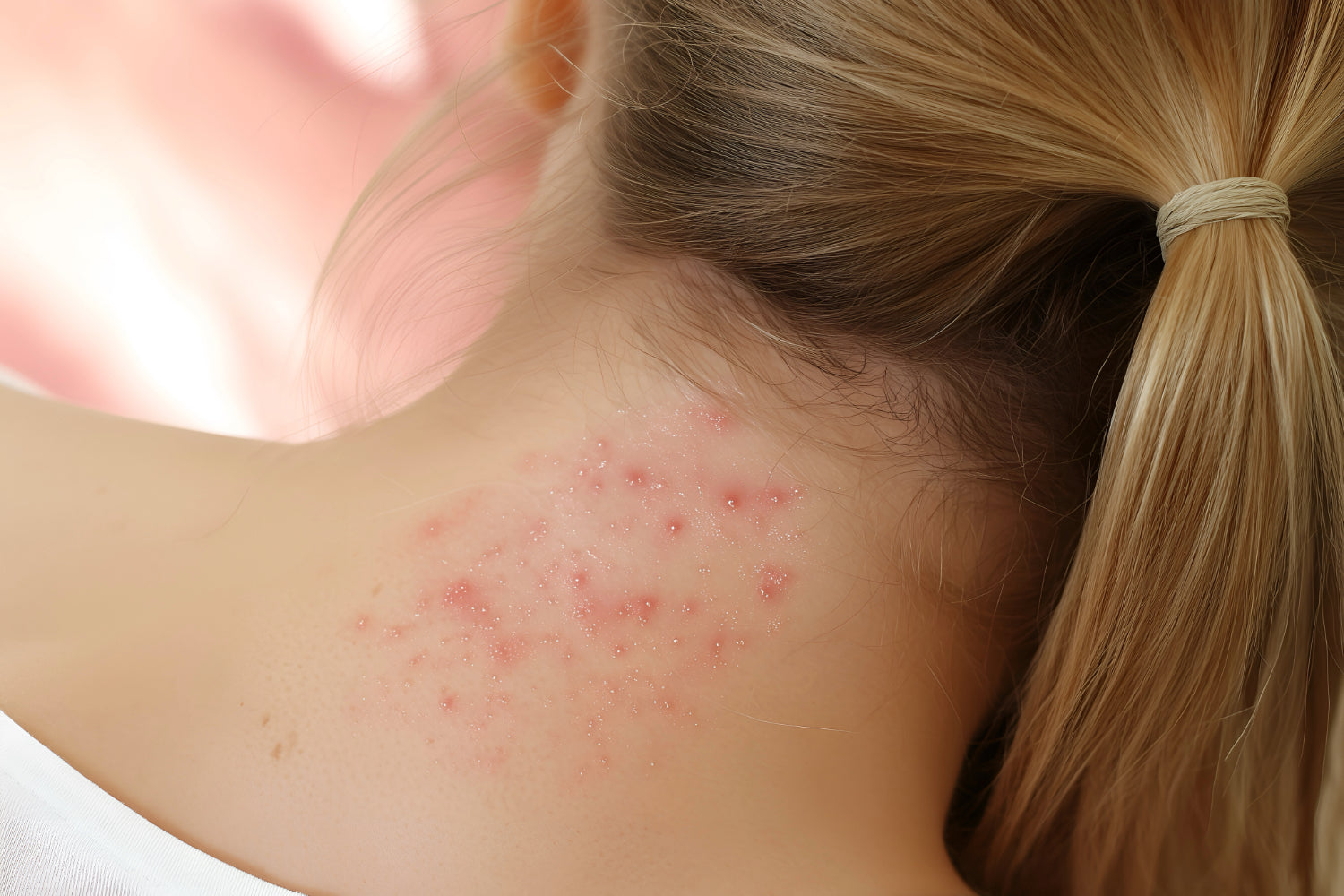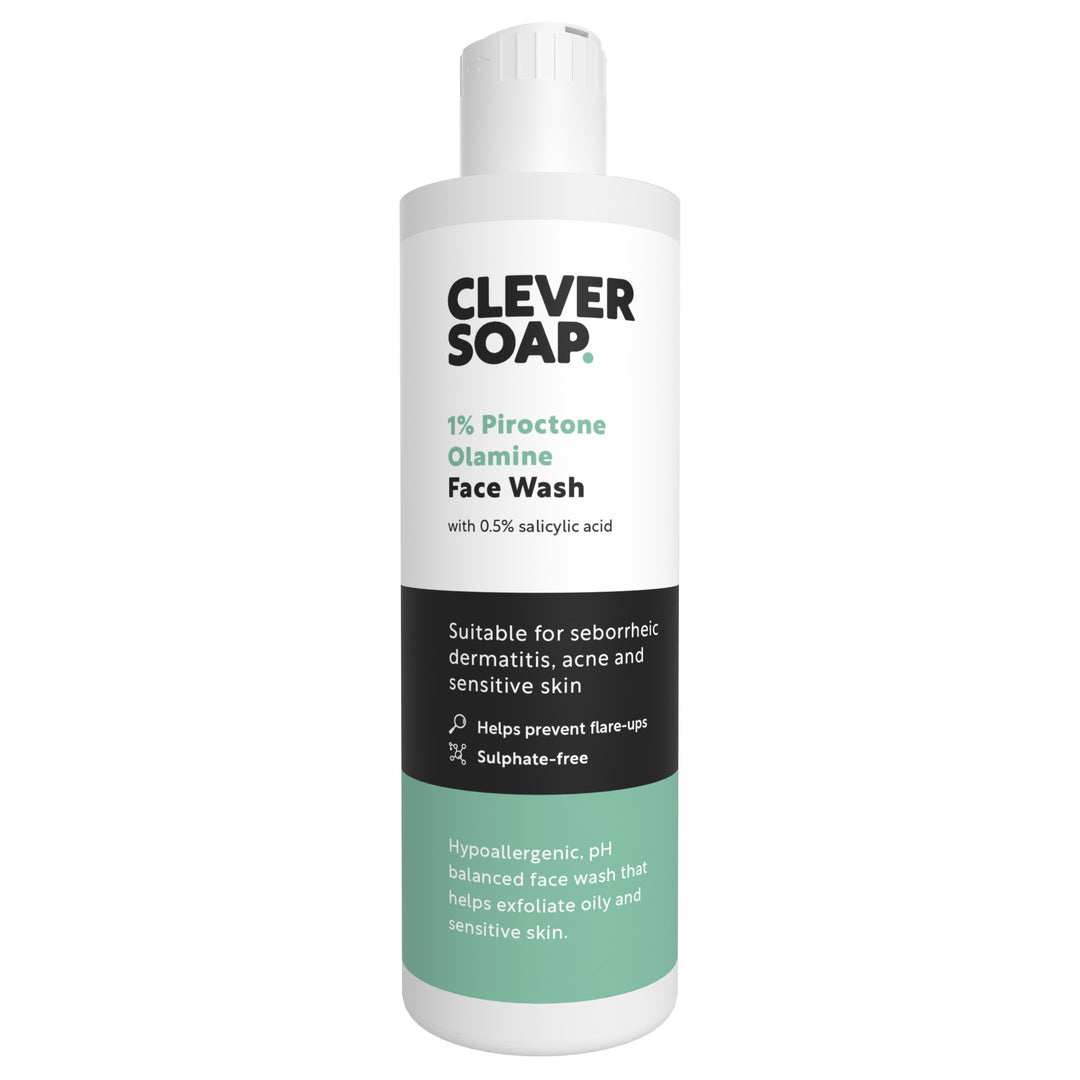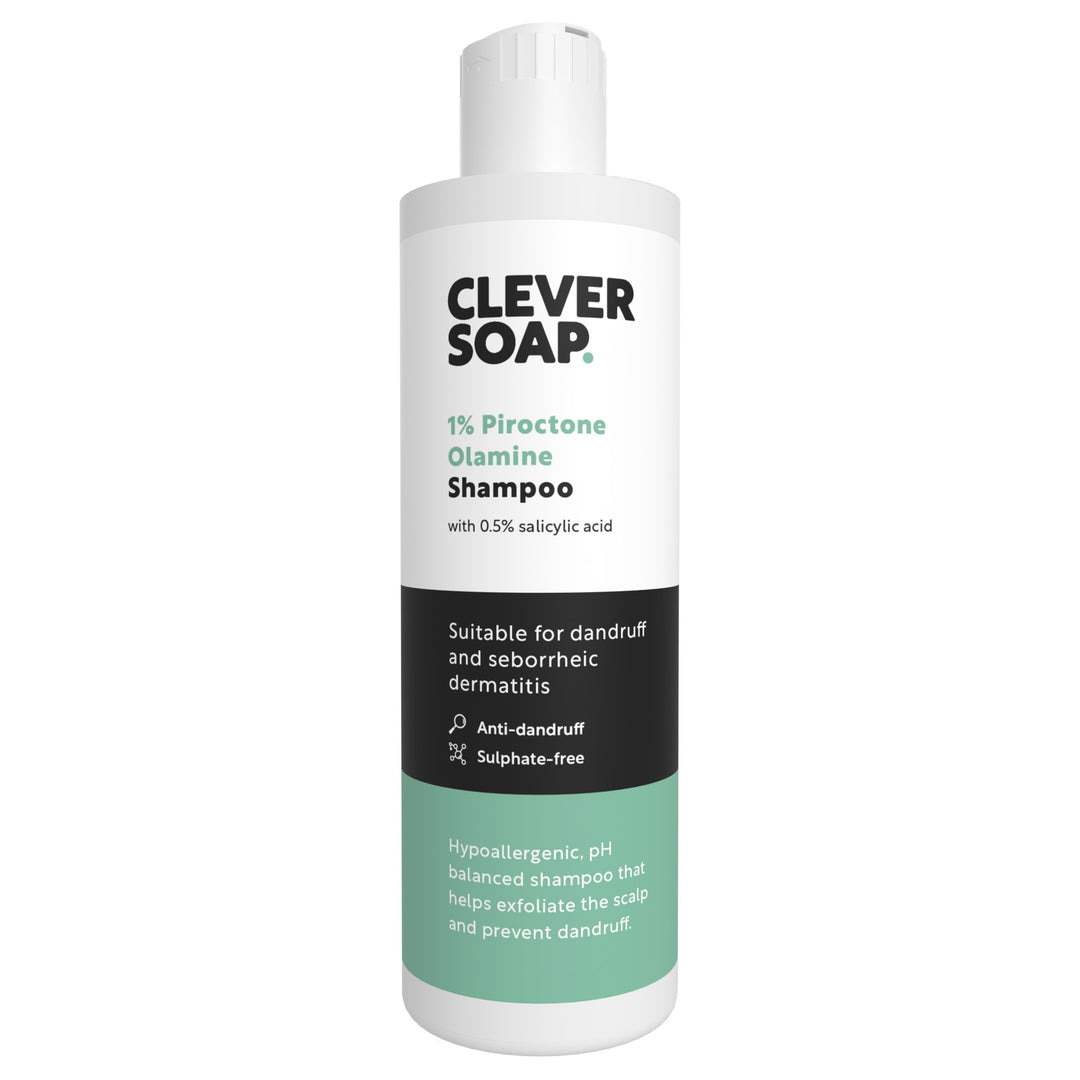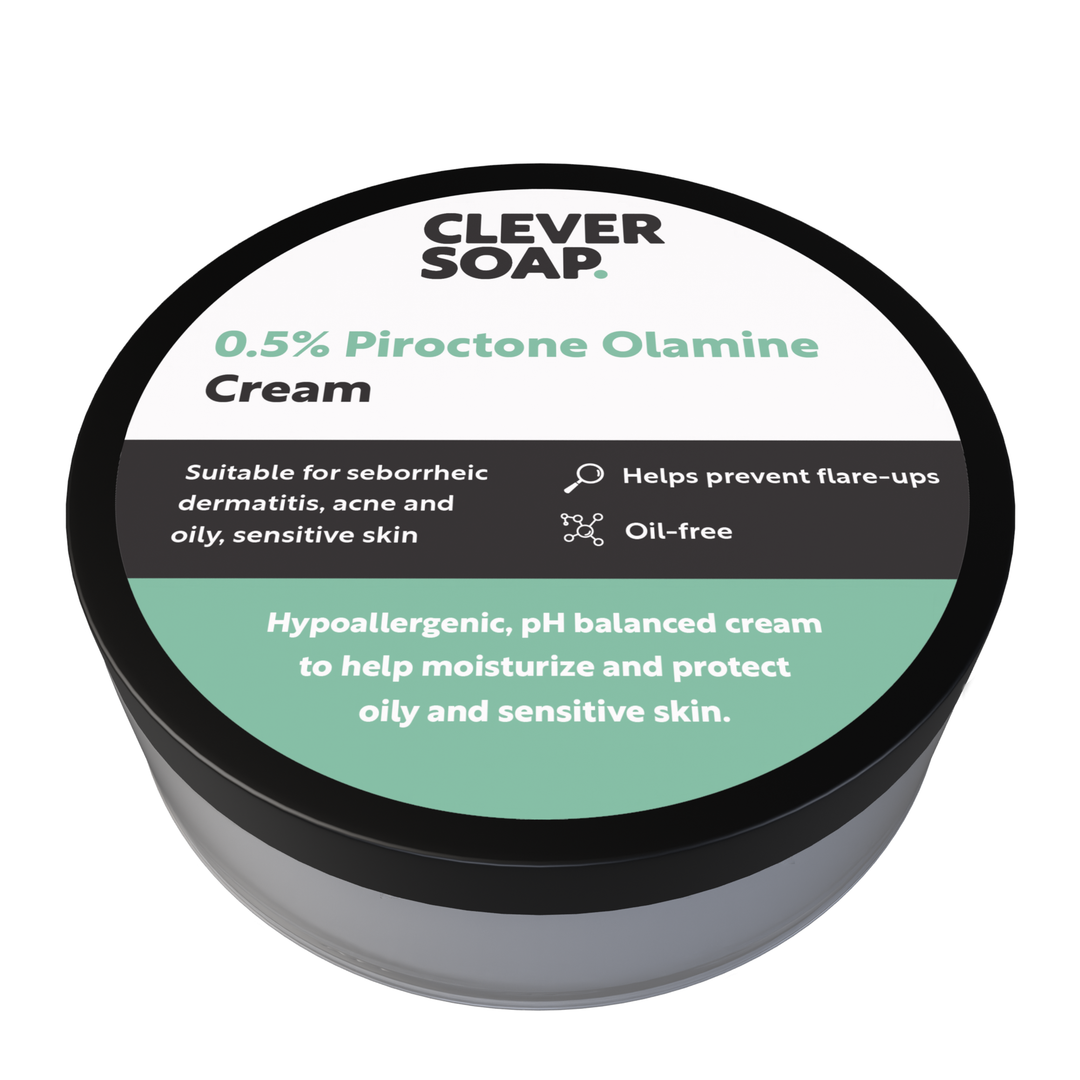U.K. DELIVERY £2.49, FREE FOR ORDERS OVER £25 | INTERNATIONAL DELIVERY FROM £9.99

Folliculitis
Table of Contents
- An Introduction To Folliculitis
- What Causes Folliculitis?
- Skin Conditions Often Confused with Folliculitis
- How To Treat Folliculitis Effectively
- The Folliculitis Blacklist: Ingredients To Avoid
- The Best Skincare Routine For Folliculitis
- Common Misconceptions About Folliculitis
- Folliculitis FAQs
- Conclusion
- References
An Introduction To Folliculitis
Folliculitis is a common skin condition where hair follicles become inflamed, often due to a bacterial, fungal, or yeast infection. It can appear as small red bumps, white-headed pimples, or itchy, painful patches of skin around hair follicles, often mistaken for acne or an allergic reaction.
While usually harmless, folliculitis can be uncomfortable, distressing, and prone to recurrence if not treated properly. It can appear anywhere on the body that grows hair, including the scalp, chest, thighs, buttocks, and neck.
Skincare Suitable For Folliculitis
Products in our green range are formulated without Malassezia-feeding ingredients, sulphates, or fragrances.
What Causes Folliculitis?
Folliculitis can be triggered by several factors. Some of the most common causes include:
-
Bacterial infection. The most frequent culprit is Staphylococcus aureus, which can enter follicles through minor skin breaks.
-
Fungal infection. Yeasts such as Malassezia species are notable causes, especially in warm, humid environments. This is referred to as Malassezia or pityrosporum folliculitis [1].
-
Viral infection. Less commonly, viruses like herpes simplex can trigger folliculitis.
-
Physical irritation. Shaving, friction from tight clothing, or blockage from oils and sweat can inflame follicles.
-
Exposure to contaminated water. Hot tub folliculitis is often caused by Pseudomonas aeruginosa bacteria in inadequately chlorinated hot tubs.
Symptoms of Folliculitis
Symptoms typically manifest at sites with hair follicles and may include:
-
Clusters of small red or pus-filled bumps. These often appear around hair follicles and may resemble acne.
-
Itching or tenderness. The affected skin may be itchy, sore, or have a burning sensation.
-
Swelling and redness. The skin around the follicles can become inflamed and swollen.
-
Lesions on trunk and back. Certain types, such as Malassezia folliculitis, commonly affect the trunk and back, especially in young adults.
-
Chronic or recurrent outbreaks. Some cases persist or recur, particularly if the underlying cause is not addressed [2].
Skin Conditions Often Confused with Folliculitis
Folliculitis can resemble a number of other skin conditions that also cause redness, bumps, or pustules. Misdiagnosis can delay proper treatment, so it’s important to understand how folliculitis differs from these.
Acne vs Folliculitis
Acne and folliculitis both involve inflamed bumps and pustules, especially on the face, back, or chest. However, acne is often caused by clogged pores and excess sebum, not infection or irritation of the hair follicle. Learn more with our detailed guide to acne here.

Contact Dermatitis vs Folliculitis
Contact dermatitis may cause redness, itching, and rash-like bumps, but unlike folliculitis, it is not centered around hair follicles and doesn’t usually form pustules. Learn more about dermatitis here.
Heat Rash
Heat rash develops when sweat ducts become blocked and inflamed, leading to small red bumps and itching. It can look similar to folliculitis, especially in hot, humid weather, but it typically affects areas where sweat collects and doesn't involve infected hair follicles.
How to Treat Folliculitis
Folliculitis treatment depends on the underlying cause, whether bacterial, fungal, viral, or related to an overactive immune response [3]. In many mild cases, good hygiene and time are enough for symptoms to resolve. However, persistent, widespread, or recurring folliculitis often requires targeted treatment, which may include topical or oral medication.
Staphylococcal Folliculitis
This is one of the most common types of bacterial folliculitis and is typically caused by Staphylococcus aureus. Mild cases with only a few pustules usually resolve on their own within a few days. For more widespread outbreaks, first-line treatment often involves topical antibiotics.
Gram-Negative Folliculitis
Gram-negative folliculitis may develop after prolonged antibiotic use, particularly in people being treated for acne. Most mild cases clear with good hygiene within 7–10 days. For more persistent infections, oral antibiotics effective against gram-negative bacteria are typically used [4].
Pityrosporum (Malassezia) Folliculitis
This fungal form of folliculitis is caused by an overgrowth of Malassezia yeast within hair follicles. Oral anti-fungals are often considered the most effective treatment, as topical products may not penetrate deeply enough into the follicle [5].
Viral Folliculitis
This form is often linked to infections such as herpes simplex virus or molluscum contagiosum. Oral antivirals like acyclovir may be used as treatment [4].
There are other forms of folliculitis that may require other treatments. As always, consult with a healthcare professional to determine the best treatment for you.
The Folliculitis Blacklist: What To Avoid
If you have folliculitis, certain skincare ingredients can worsen irritation or promote infection. You may want to avoid the following types of products as a precaution:
- Those that clog pores or follicles, with ingredients such as coconut oil, mineral oil or waxes.
- Those that trap sweat and oil, such as heavy makeup and greasy moisturizers.
- Those that contain fragrances or sulphates.
In short, be careful using products that can clog the pores or harsh exfoliants or irritants which may irritate inflamed follicles.
Best Skincare Routine for Folliculitis
Folliculitis can be aggravated by friction, trapped sweat, occlusive products, and even certain skincare ingredients. The key is to minimize irritation, support the skin barrier, and avoid pore-clogging products, in addition to any treatments that may be prescribed. Here's a useful routine you can follow to help manage folliculitis.
Morning Routine
- Cleanse Gently. Use a fragrance-free, non-comedogenic cleanser. Our Piroctone Olamine Face Wash is suitable.
- Apply Treatment if Prescribed. If your healthcare provider has prescribed a topical treatment, apply it after cleansing or as directed.
- Light Moisturizer (Optional). Choose an oil-free, non-comedogenic moisturizer if your skin feels dry or irritated. Avoid products with esters, heavy oils, or silicones that can trap heat and sweat. Our Piroctone Olamine Cream is suitable.
- Sunscreen. If the affected area is exposed to the sun, apply a non-comedogenic mineral sunscreen containing zinc oxide. This protects the skin without clogging pores.
Evening Routine
- Cleanse Again. Wash off sweat, bacteria, and environmental residue using the same gentle cleanser. This is particularly important if you’ve been sweating or exercising during the day.
- Reapply Treatment (if applicable). If your treatment plan includes a second application, apply as directed.
- Moisturize Lightly. Use the same moisturizer from the morning routine or skip if your skin doesn’t feel dry.
Common Myths & Misconceptions About Folliculitis
Despite being a common condition, folliculitis is often misunderstood. Here are some of the most common myths and misconceptions.
Folliculitis Is Always Caused by Poor Hygiene
This is one of the most widespread myths. While good hygiene is important, folliculitis is not necessarily caused by being unclean. In many cases, it results from bacteria, yeast, friction, shaving, or even reactions to certain medications or products.

It’s Just Acne
Folliculitis is sometimes mistaken for acne because both conditions can present as red bumps or pustules. However, folliculitis is an inflammation of the hair follicle often due to infection, while acne is typically caused by clogged pores and sebum buildup. The two conditions therefore usually require different treatments.
It's Contagious
Not all forms of folliculitis are contagious. While bacterial or fungal folliculitis can spread through shared towels or close contact, other types are not infectious. Understanding the underlying cause is key to determine this.
Folliculitis Only Affects the Scalp or Beard
Folliculitis can appear anywhere on the body where hair grows, including the arms, legs, back, buttocks, chest, and even underarms. It is not limited to the scalp or beard area, and different areas may be affected depending on the cause.
Once Treated, Folliculitis Won’t Come Back
For many, it can be recurrent, especially if the root cause is ongoing (like friction or sweat). Proper skincare and treatments may be required to prevent future flare-ups.
Folliculitis FAQs
Can folliculitis be caused by hair removal?
Yes. Shaving, waxing, and epilation are common triggers, especially in the bikini or beard areas.
Can I use moisturizers with folliculitis?
Yes, but stick to lightweight, non-comedogenic formulas free from heavy oils and fragrances.
Should I pop the bumps?
No, squeezing them can worsen inflammation or spread infection.
Conclusion
Folliculitis is a common and treatable skin condition that is often mistaken for acne but can arise from a wide range of causes, including bacteria, yeast, viruses, or even irritation from shaving or friction. While it can appear anywhere on the body, it’s especially common in areas where sweat, friction, or oil buildup is present.
Fortunately, most cases of folliculitis are mild and respond well to topical treatments, gentle skincare routines, and changes in personal care habits. Using non-comedogenic, fragrance-free products and avoiding pore-clogging ingredients can make a big difference. Reducing friction, managing sweat, and practicing good hygiene are also key to preventing flare-ups.
In more persistent or recurrent cases, or when symptoms worsen, it’s important to seek advice from a medical professional who can recommend appropriate topical or oral treatments based on the specific type of folliculitis.
References
[1] Cohen, Philip R. 2018. “Systemic Treatments for Melasma: Adjuvant Therapy with a Novel Topical Agent.” International Journal of Dermatology 57 (3): e20–21. https://doi.org/10.1111/ijd.13887.
[2] Yong, AM, SY Tan, and LC Tan. 2021. “An Update on Pityrosporum Folliculitis in Singapore from a Single Tertiary Care Dermatological Centre.” Singapore Medical Journal 62 (10): 526–28. https://doi.org/10.11622/smedj.2020068.
[3] Winters, Richard D., and Mark Mitchell. 2023. “Folliculitis.” PubMed. Treasure Island (FL): StatPearls Publishing. 2023. https://www.ncbi.nlm.nih.gov/books/NBK547754/.
[4] Luelmo-Aguilar, Jesús, and Mireia Sàbat Santandreu. 2004. “Folliculitis: Recognition and Management.” American Journal of Clinical Dermatology 5 (5): 301–10. https://doi.org/10.2165/00128071-200405050-00003.
[5] Hald, M, M Arendrup, E Svejgaard, R Lindskov, E Foged, and D Saunte. 2015. “Evidence-Based Danish Guidelines for the Treatment of Malassezia-Related Skin Diseases.” Acta Dermato Venereologica 95 (1): 12–19. https://doi.org/10.2340/00015555-1825.



